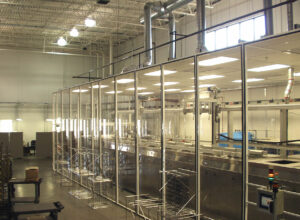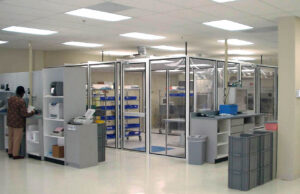Staying on top of the medical market requires companies to be highly flexible, which can only be achieved with controlled environments to work in. Medical cleanrooms have evolved significantly over the past decade and now offer solutions for a wide range of service providers and manufacturers. In this article, you can read our short guide to modular medical cleanrooms.
What is the function of medical cleanrooms?
Recirculating air provides a low particle concentration environment within a clean room in a factory or laboratory. Cleanrooms are commonly used in manufacturing and testing processes to prevent contamination from airborne particles, microbes, aerosol particles, and various gasses. When the reproducibility conditions of the activity require it, cleanroom air purification also maintains temperature and humidity within strict limits.
A room’s size and cleanliness level must be adapted to the specific application since airborne contaminants can never be completely removed. Therefore, standard categories are defined to determine the maximum permissible cleanliness levels depending on the contaminant concentrations. These standards have been known as medical cleanroom classification.Â
While clean rooms are utilized by many industries, including aerospace, automotive, IT, and nanotechnology, the medical industry has the largest market for them. The development of vaccines and treatments through pharmaceutical products and the manufacture of life-saving medical devices is essential. Medical cleanrooms fall into three categories: Research cleanrooms, medical device cleanrooms, and pharmaceutical cleanrooms. Different cleanroom designs are suitable for different types of facilities depending on the objective and clean room classification requirements.
A medical device is a specialized product that diagnoses, treats, and cures a patient. Medical device components usually come into contact with tissues and membranes, making them susceptible to contamination and infection. To prevent this, they must also be able to be thoroughly disinfected. To ensure the quality, safety, and efficacy of medical devices, the cleanroom requirements for medical device manufacturing and testing are strictly outlined.Â
It is important that a cleanroom for medical devices meets ISO Class 5-8 standards. The different stages of medical device production, assembly, and packaging have their own cleanliness requirements. Cleanrooms used for manufacturing non-critical and semi-critical medical devices fall under ISO Class 7-8, while cleanrooms for critical devices (such as surgical instruments and implantable devices) must meet ISO Class 5 or better.
A pharmaceutical cleanroom is another important application, as it is here that chemical cures and remedies are developed to improve health and save lives. Minor contaminants can have a serious negative impact on the results of medical trials or the effectiveness of treatments and can even be life-threatening. Therefore, the cleanroom design for pharmaceuticals and medical device manufacturing and testing should only be performed by highly experienced professionals to ensure compliance with strict regulations.
Providing economical solutions for all your cleanroom needs, Modular Cleanrooms Inc. has been building quality modular and portable cleanrooms for over 40 years. A variety of cleanroom designs and medical cleanroom equipment are available, from Modular Cleanrooms to fit any budget, setup, or design.
If you have any professional questions or would like to discuss a new cleanroom, expansion, or a complete new build, please don’t hesitate to contact us. With the latest technologies, we can assist you with planning and budgeting your entire project.

